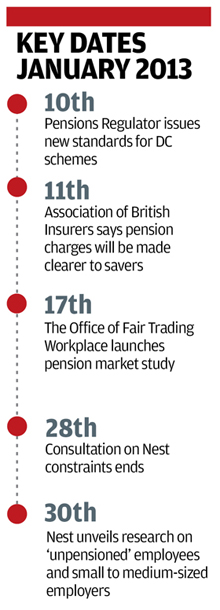In depth: all change for DC
January saw a glut of consultation and policy change for defined contribution schemes. Here is a summary of the big changes.
The Office of Fair Trading to review defined contribution pensions
The OFT is to examine whether DC workplace pension schemes deliver the best value for money for savers. A report is due in August.
The basics
There are currently four million saving into DC pensions, but this could rise to 10-13 million by 2018. Many, including the Labour party which called for the OFT review, believe it is a moral compulsion to ensure DC is fair for all before this happens.
In the words of the OFT, the focus will be on whether there is “sufficient pressure on pension providers to keep charges low, and the extent to which information about charges is made available to savers”.
Pension providers, who some might suspect will lose from the results of the review, have publicly supported it and declared they are happy to work with it.
The new Master Trust Association (made up of B&CE, BlackRock, BlueSky, Legal & General, National Pension Trust – Xafinity, Now Pensions, Pensions Umbrella Trust, Salvus, SEI, Standard Life, SuperTrust UK and The Pensions Trust) has called for providers to be given quality marks to help smaller employers choose the best scheme for their staff.
The only negative comment came from Paul Macro, retirement partner at Mercer, who said: “We urge the OFT to be clear on what is meant by ‘value for money’ and to consider pension members’ interests and benefit outcomes as paramount. Higher charges which deliver what some members would like, such as guarantees, should not be castigated and driven out.
“The key focus should be investments and services that are appropriate for the needs of specific groups of employee, combined with transparency of charges, and adequate levels of contributions.”
Leading pension providers to make charges clearer
Leading providers have committed to showing pension savers full disclosure on charges using standard definitions by December 2015.
The intention is that this will be expressed in pounds and that there will be disclosure of the previous year’s investment transaction costs.
Stephen Gay, director of life, savings & protection at the Association of British Insurers, said: “It is imperative that savers have complete confidence that the industry is open and transparent with them.”
Steve Webb, pensions minister, called it a “welcome step”.
Regulator publishes 31 new standards for DC schemes
There is a consultation on new quality standards for trust-based DC schemes (including mastertrusts).
Each will be expected to adopt a disclosure framework to demonstrate how they comply with the standard, or to be able to explain any inconsistencies.
The standards will set out good practice in areas such as value for money, transparency of costs and charges, and member communications.
Where trustees fall short of the standards the regulator can issue fines or remove trustees and replace them with new ones.
On this point, chief executive of the regulator Bill Galvin says: “Members bear risks where DC schemes perform poorly… so it’s vital that schemes are run by capable people who act in members’ interests – from enrolment to retirement.”
Nest research on small and medium-sized employees
One of the widest-ever surveys of SMEs was carried out by the National Employment Savings Trust at the tail end of 2011. These are some of its key findings:
It is imperative that savers have complete confidence that the industry is open and transparent
- Almost all (96 per cent) are aware of the workplace pension reforms and most have sought or plan to seek advice.
- For the smallest employers advice is likely to be sought from IFA firms (68 per cent for 50-99 workers, 58 per cent 100-999). For others it is their pension provider they will be most likely to turn to (49 per cent of firms with 1,000-4,999 employees, 51 per cent of firms with 5,000 plus employees).
- Around three-quarters of employers with more than 50 employees plan to use their existing pension scheme to comply with auto-enrolment.
- Larger employers are more likely to put a new scheme in place alongside their current scheme.
And in the report Nest insight – taking the temperature of automatic enrolment, it says: “The administrative burden is the biggest perceived operational challenge presented by the reforms. Three-quarters of employers say that ease of scheme set-up and ease of day-to-day administration are very important or of utmost importance when considering which scheme to choose.”
The call for evidence on Nest restrictions ends
In November 2012, Webb announced a consultation on whether Nest should be unshackled from restrictions, such as the prevention of transfers-in or out.
Responses to the consultation
John Lawson head of policy corporate benefits at Aviva, said: “Pensions and automatic enrolment are complicated enough without adding in further barriers. People shun pensions because of this complexity and we should grasp every opportunity to make pensions as easy and customer-friendly as we can.”
Robin Hames, head of marketing at Capita Employee Benefits, added: “The market has evolved and a number of employers are considering a two-tier approach to auto-enrolment as they have an employee segment that would be well served by Nest.
“The shackles, especially regarding transfers, have become counterproductive, adding an unhelpful additional layer of complexity.”
Most Viewed
- What does Labour have in store for the pensions industry?
- LGPS latest: GLIL backers invest £475m for UK infrastructure push
- Dashboard costs rose by 23% in 2023, figures show
- Border to Coast launches UK strategy in major private markets push
- How the pensions industry can better support people with mental health problems


